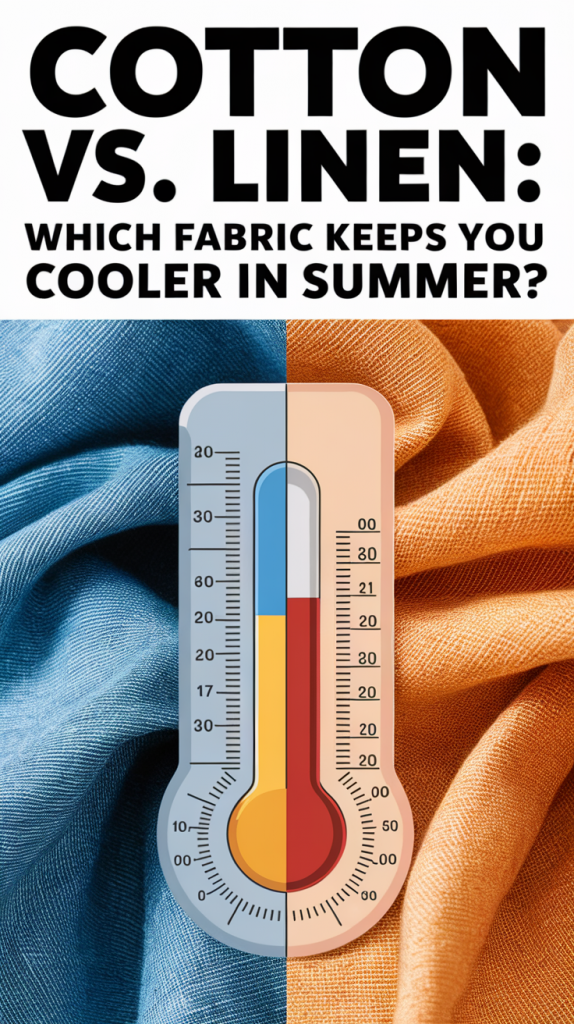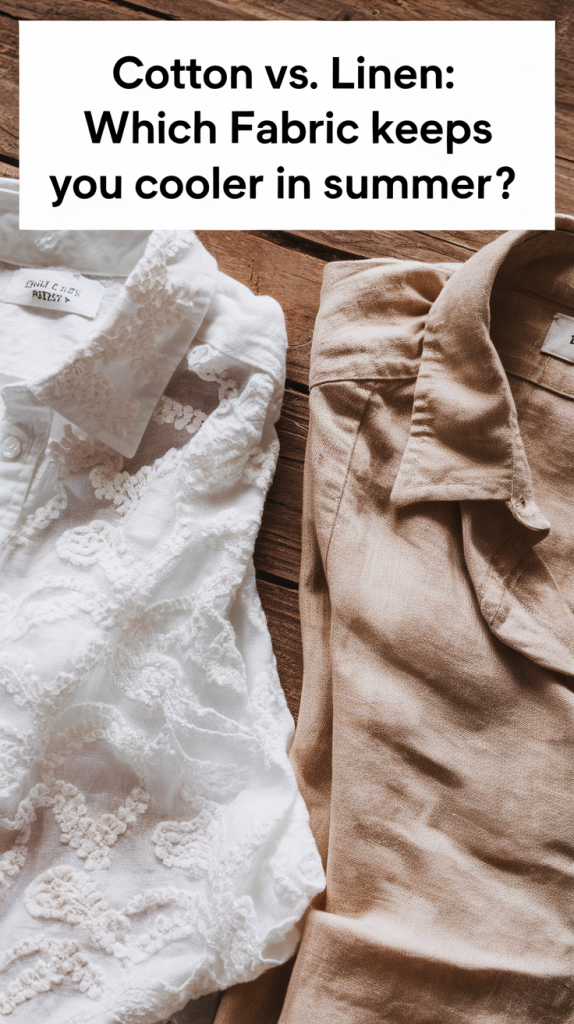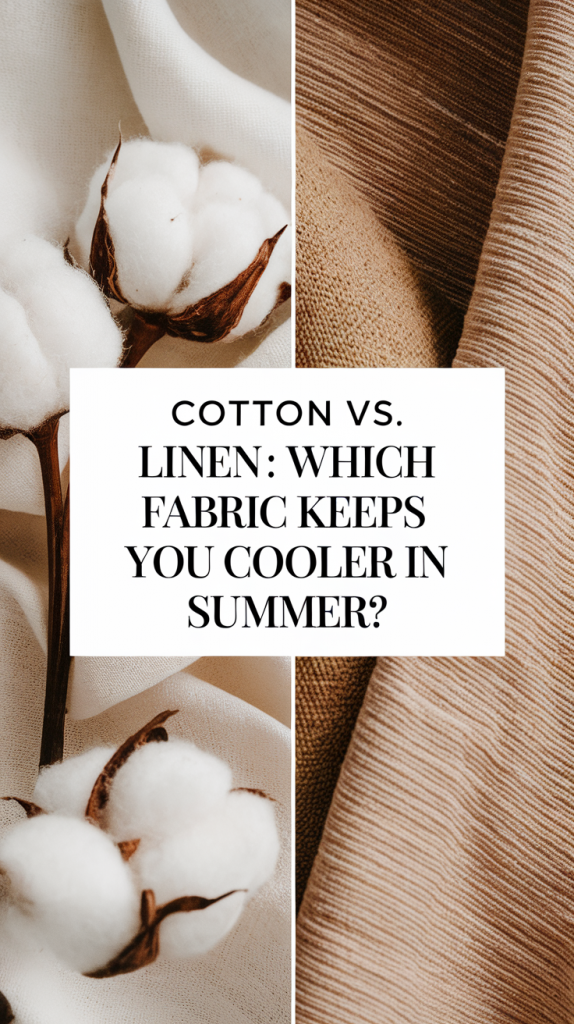Cotton vs. Linen: Which Fabric Keeps You Cooler in Summer 2025?
Male and female members of society are unaware that selecting winter fabric in summer can increase body temperature to multiple degrees. Heatwaves will increasingly affect most U.S. regions by 2025 so individuals will need to depend on their clothing selection to stay cool in addition to air conditioning systems. Your choice of fabrics during summer months should fall between natural materials, leading to cotton or linen being your best options in wardrobes.
The piece dissects the genuine distinctions between cotton and linen fabrics to find out which material stays coolest during summer months. This article provides you with definitive answers alongside relative advantages and disadvantages, along with expert advice and specific directions for selecting the optimal fabric for summers.

Who should read this?
- If you’re constantly sweating through your clothes,
- If you plan to travel somewhere hot this summer, let me know.
- If you’re looking for breathable, stylish summer outfits, look no further.
- Consider making eco-conscious wardrobe choices.
Let’s settle the debate: cotton vs. linen. Which one should you trust to keep you cool?
Why Fabric Choice Matters in Summer
Your body reacts strongly to heat exposure beyond what you can imagine. Wearing apparel functions as protection between your skin and sunrays. Fabrics that trap heat can cause excessive sweating, making a pleasant day uncomfortable. To keep your skin comfortable through hot summer days, you should select materials that let sweat dry and provide both lightness and air permeability.
Natural fabrics that include cotton and linen gain front-over-synthetic fabrics starting with polyester. The clothes demonstrate unequal performance criteria, although they share a common use.
What factors indicate suitable clothing items for hot weather?
- Air permeability (aka breathability)
- Moisture absorption and release
- Texture against the skin
- Weight and weave of the fabric
Let’s dig into what each fabric really offers.
Cotton vs. Linen: The Essentials
What Is Cotton?
Cotton is a soft fiber that comes from the seed hairs of the cotton plant. It has been a clothing staple for centuries due to its comfort, affordability, and versatility.
Advantages:
- Very soft against the skin
- Easy to wash and maintain
- Widely available in different weights and styles
Disadvantages:
- Absorbs moisture and retains it
- Can cling to the body when wet
- Less breathable compared to linen
What Is Linen?
The stalk of the flax plant yields linen. Known for its unique texture and breezy feel, linen is a longtime favorite in regions with hot climates.
Advantages:
- Extremely breathable
- Dries quickly after absorbing moisture
- Has a naturally crisp, elegant texture
Disadvantages:
- Wrinkles easily
- Can feel coarse initially (though it softens over time)
- Slightly more expensive than cotton

Which Fabric Is Cooler: Cotton or Linen?
Breathability Showdown
The ventilation properties of linen exceed those of other materials. Because linen fibers have greater thickness and a broader structure, linen lets the heat dissipate conveniently. Linen allows better airflow during hot temperatures while providing the perfect air circulation benefits on such hot days.
The delicate weave in cotton material offers proper air ventilation; however, heavy cotton fabrics with multiple threads restrict airflow levels.
Moisture Management
Less moisture clings to linen because it holds it and then rapidly lets it go for dry comfort. Cotton absorbs moisture extremely well yet keeps liquids within its fibers so it stays wet against your body, thus creating sticky, unpleasant clothing textures.
Comfort Level
The texture of cotton gives a smooth surface to the skin while creating fewer irritations, particularly for people with sensitive skin. The initial reservation about its texture transforms into smoothness during washing cycles. The dry nature of linen creates a temperature-cooling effect that exceeds the cooling potential of cotton during hot days.
Let’s Compare: Key Differences in a Glance
| Feature | Cotton | Linen |
|---|---|---|
| Breathability | Moderate | Excellent |
| Moisture Wicking | Low | High |
| Softness | Very soft | Rough at first, softens over time |
| Durability | Good | Excellent |
| Care Requirements | Easy (machine wash) | Medium (best to air dry) |
| Wrinkle Resistance | Moderate | Low (wrinkles easily) |
| Sustainability | Medium (organic is better) | High (low water use) |
Best Use Cases: When to Choose Cotton or Linen
Cotton Is Ideal For:
- Mild to moderately hot climates
- Everyday wear: t-shirts, underwear, casual dresses
- Those with sensitive or allergy-prone skin
- Kids’ clothing
Linen Is Ideal For:
- Very hot and humid conditions
- Travel outfits that dry quickly
- Business-casual summer looks
- Fashion-forward pieces like wide-leg pants and oversized shirts
Ever tried linen sheets during a heatwave? Total game-changer.

What About Style?
Linen’s relaxed, slightly wrinkled look pairs perfectly with summer aesthetics. Think beach picnics, wine tastings, or open-air concerts. It’s no coincidence that fashion brands often release linen collections around April or May.
Cotton, being smoother and more form-fitting, is great for layering or structured silhouettes. It transitions well between casual and semi-formal.
Styling Tips:
- Pair linen with leather sandals and straw hats for a vacation-ready look.
- Mix cotton tees with denim shorts or chinos for everyday comfort.
- Avoid dark-colored cotton on sunny days—it holds heat more
Care and Maintenance
Cotton:
- Machine washable (cold or warm water)
- Tumble dry low or line dry
- Iron on medium heat if needed
Linen:
- Wash in cold water
- Air dry to prevent shrinkage
- Iron while still damp for best results
Pro tip: Embrace linen’s natural wrinkles. That’s part of its charm.
Sustainable Fashion: Cotton vs. Linen
The environmental benefits favor linen fabric. The production of linen happens with minimal water consumption and minimal chemical application stages; therefore, it ranks as an exceptionally sustainable fabric.
Conventional cotton, however, is resource-intensive. Organic cotton stands as a sustainable choice because it develops without poisonous pesticides along with using fewer water supplies.
Organic cotton production consumes 91% less water in comparison to traditional cotton cultivation methods, as the Textile Exchange explains.
Final Verdict: Which Should You Choose in Summer 2025?
Go with Linen if you:
- Sweat easily or live in a humid area
- Prefer clothes that dry quickly
- Value breathability over softness
Choose Cotton if you:
- Have sensitive skin
- Want low-maintenance, machine-washable clothing
- Prefer a smooth, classic feel
Best idea? Mix both. Use cotton for daily essentials and linen for elevated summer looks.
Let’s Hear From You
Have you tried both cotton and linen in hot weather? What works best for your lifestyle?
Share your experience in the comments below or tell us: What fabric do you swear by during a heatwave?
Don’t forget to share this article with someone who’s always sweating through summer!

